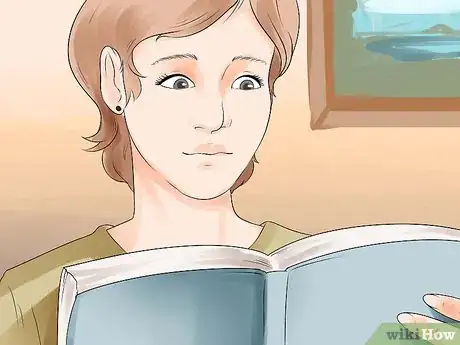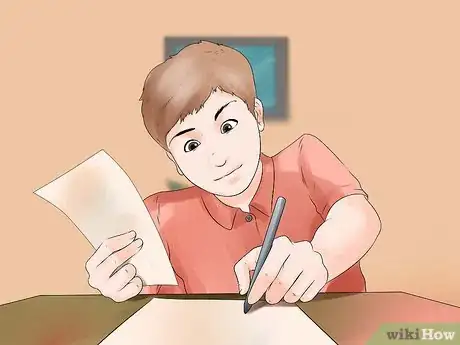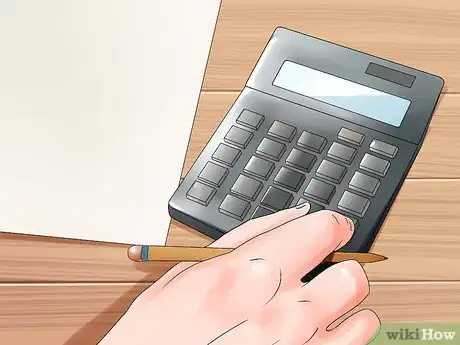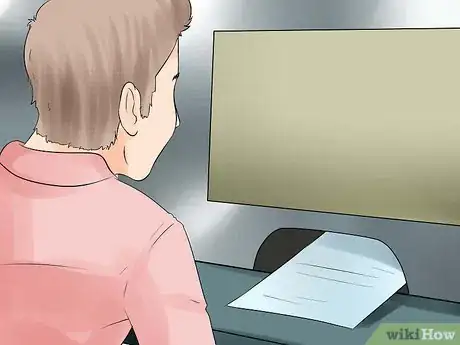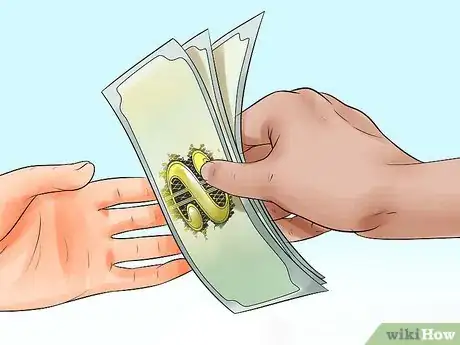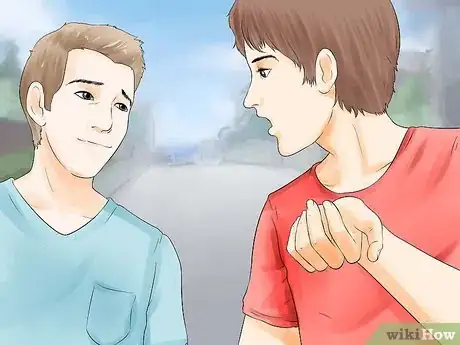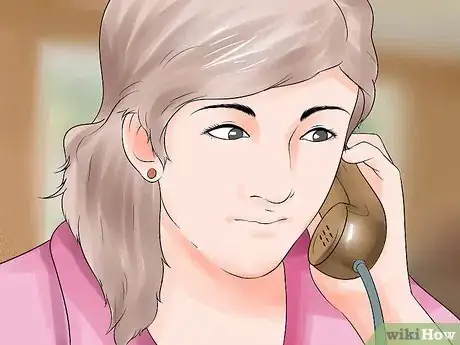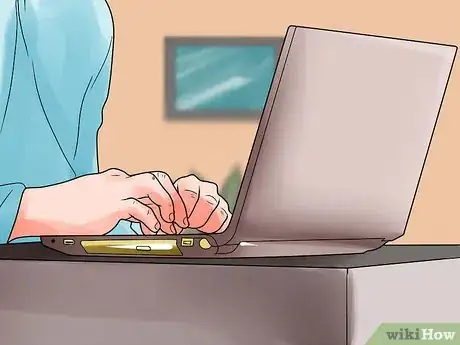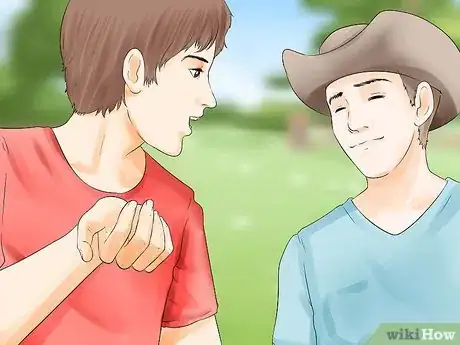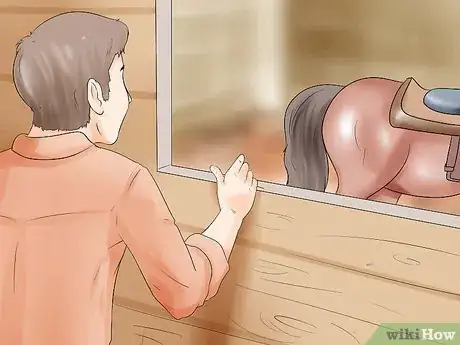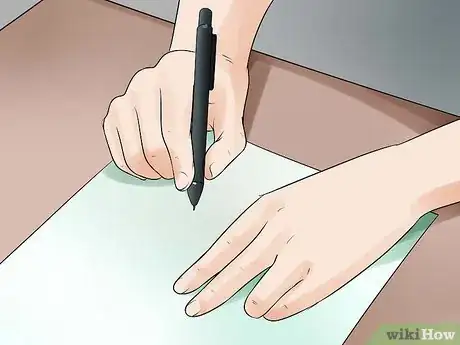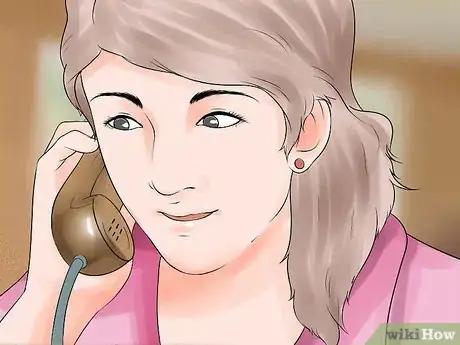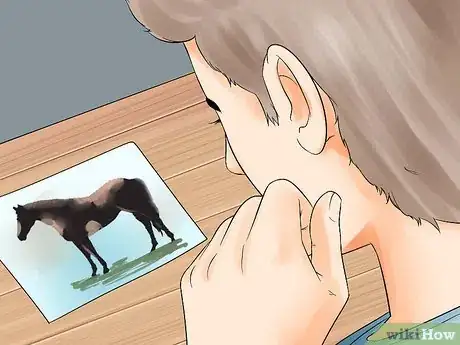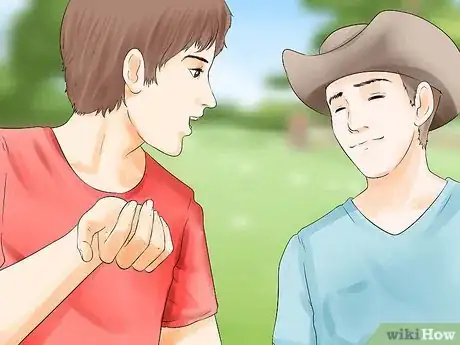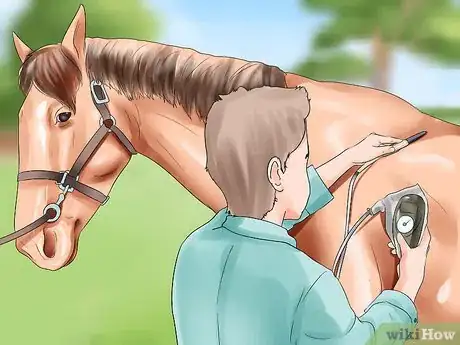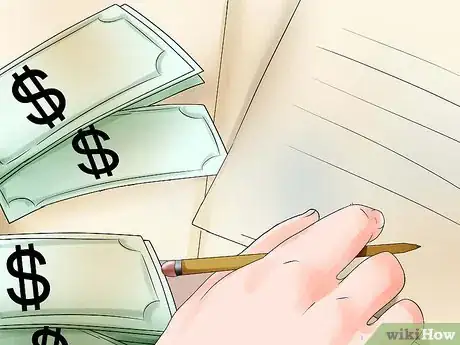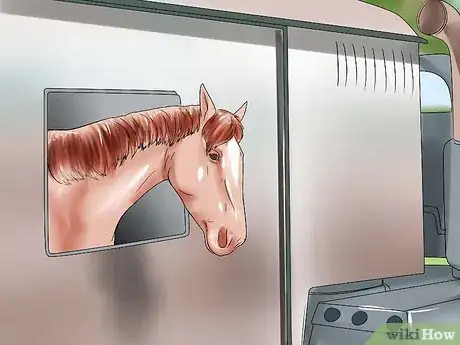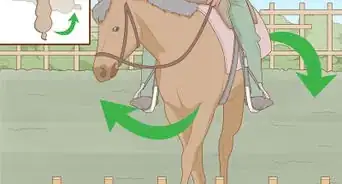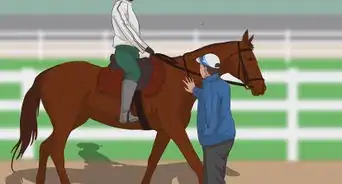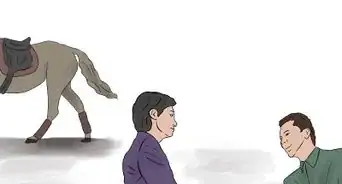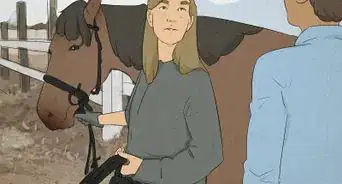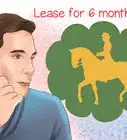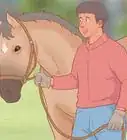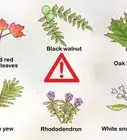This article was co-authored by Ryan Corrigan, LVT, VTS-EVN. Ryan Corrigan is a Licensed Veterinary Technician in California. She received her Bachelor of Science in Veterinary Technology from Purdue University in 2010. She is also a Member of the Academy of Equine Veterinary Nursing Technicians since 2011.
There are 8 references cited in this article, which can be found at the bottom of the page.
This article has been viewed 198,762 times.
Buying a horse is a big investment, and owning one takes a lot of time and money. There are a lot of pitfalls that can appear when buying a horse that may not only be expensive, but heartbreaking. Because of this, it is important to understand how to go about buying and vetting a horse. When you find the right horse and you buy it in a way that feels fair and clear, you are starting your long and happy relationship together in a positive way.
Steps
Deciding to Buy a Horse
-
1Spend time with horses and learn about them. Before you buy a horse, you should have extensive experience interacting with horses and knowledge of their care. This should include understanding basic horse health and equine first aid.
- Most people who buy horses have experience riding horses and caring for them before they make the step to buy a horse.
- If you want more experience, volunteer to work at a local stable. You can also volunteer at rescues and ‘riding for the disabled’ barns, which will allow you to get to know horses better and give back at the same time. Working with horses will give you a better idea of what owning horses is like and what the work involved entails.
- You could also shadow people who own horses to see what a typical day caring for a horse is like.
- Be sure that your knowledge of horses includes local laws concerning them. These can include equine liability laws, whether there are local taxes on livestock that can reproduce (mares & stallions), and fire code laws for stables.
-
2Build a network of horse people. Find and learn about boarding facilities, tack shops, feed stores, farmers that produce hay, vets, and farriers in your area, and where the nearest equine hospital and horse ambulance service is.
- Make sure that you have access to several hay suppliers, as a horse goes through around 2% of its body weight in hay daily. Visit your horse friends' barns and ask them where they buy their hay. While you are there, also inspect the quality of their hay. Hay bales should be heavy and not damp, moldy, or contain other grains.
- Get the contact information of multiple farriers in case your regular one is busy. Treat your farriers well and try not to bother then while they're working. Make sure your horse is brushed and waiting for their arrival in cross ties.
- Find a reputable equine vet. Find one that knows what they are talking about. They should also be friendly and explains things about keeping your horse healthy. You may also want to get in touch with a trainer who can help you deal with psychological or training issues, should they arise.
- Locate and visit your local tack and feed stores, as you will be visiting these frequently to get supplies and make more equine contacts.
Advertisement -
3Calculate and budget for the cost of a horse and its upkeep. In order to determine whether you can afford a horse, you need to take all costs into consideration. The general cost, minus boarding, typically ends up between $2500 and $4000 USD per year. However, price out all aspects of care and consider the overall cost of these factors:[1]
- Feed (hay, grain, and supplements)
- Halter, lead rope
- Saddle, saddle blanket, bridle, bit, cinch
- Grooming kit
- Transport fee (if applicable)
- Boarding fee per month (if applicable)
- Deworming and vaccines
- Regular vet visits
- Regular farrier visits (shoeing or trimming)
- Emergency treatment
- Riding lessons
- Training
-
4Consider alternatives to buying a horse. You have some options when it comes to getting a horse. You can get a horse on loan. You can also share a horse with someone else, or you can lease a horse if you like. If you just want to spend time with horses, consider volunteering at a horse rescue in your area.[2]
- Loans can be long or short term. You should agree on the length of the loan with the owner before you take the horse.
- Sharing a horse involves caring and riding a horse for part of the week, as well as making a financial contribution to the horse's upkeep and veterinary bills (both maintenance and emergency).
- Leasing a horse requires a signed contract, a monthly fee, and also a commitment of your time. Usually a leased horse will stay at the leaser's place and be ridden, fed, and cared for by the leaser. Some leases are long term and others are short.
-
5Find a suitable place to keep your horse. If you do not own land and are unsure of the local boarding facilities, look for ads in local papers, equestrian magazines and on the Internet. Ask in local tack shops and riding schools. If a yard (stable) has no spaces, ask them to recommend another yard.[3]
- Keeping a horse on your own land is cheaper but requires a bigger commitment of time and effort on your part. It is also beneficial to training because no one else will be able to handle the horse without your knowledge.
- Keeping a horse at your home also requires quite a bit of space. You should have several acres of land if you want to keep a horse on it. This will give you enough space for grazing land and stables. Ideally, you should be able to keep more than one horse on your property, as horses are herd animals and do best when they aren’t by themselves. This doesn’t mean you need to own two horses. As an alternative, you can offer to board horses for others.[4]
-
6Visit potential boarding facilities. Ask them about hours, cost, feeding schedule, and what you'll be expected to do. If it's rough board, you'll have to feed and water your horse and clean its area daily. If it's full board, all you have to do is pay. Choose a boarding facility that meets your horse's needs (e.g. safe, all-year turnout) and your needs in a comfortable environment. Keep in mind that horses are herd animals and sleep for only two hours a day. Consider keeping them in pasture with free access to their stall if they choose.[5]
- Secure a space at a boarding facility if you like it. Spaces are rarely available at good yards and they tend to fill fast. Be prepared to pay a weekly/monthly fee to reserve a space until your horse arrives.
- If money is tight, ask the facility if they offer a work-share program. This is where you work at the barn a few days a week in exchange for money off your board or free perks. Usually this involves helping muck out stalls or feeding the horses.
Searching for a Horse
-
1Ask a knowledgeable horse-loving friend to help you. A friend that has experience with horses should be able to help you find resources and learn what to do when buying a horse. It is great if your friend can also offer helpful advice in both the business end of buying a horse and the training world of horses.
- You should ask this friend to help you throughout the buying process. They should go along with you to your appointments as an extra set of eyes and ears so that they can pick up on things that you may not be aware of.
-
2Get the word out that you're looking for a horse. Let your horse-loving friends know that you're looking for a horse. Tell people like farriers, vets, and tack shop owners. You can also tell your riding instructor and the employees at any stables you frequent. These people often have clients that are selling horses and they may be able to help you try out particular horses that are coming up for sale. Many times, the owner is most concerned that they have a loving home and a recommendation from a friend can only help your case.[6]
- People who work with horses professionally tend to have a lot of contact with various horse owners, so they are often the first ones to learn about available horses in their area.
- Look for sales ads in equine veterinarian offices, boarding stables, and tack stores. If you don't see any posted, ask an employee where they're located.
- The sooner you let your friends know you're looking for a horse, the better. Oftentimes finding the right horse isn't a quick task. It's better to start looking for the right fit sooner rather than later. You'll need to find a horse that's the right size for you and that you are able to handle with your level of experience.
-
3Search horse ads in local tack shops, vet clinics, magazines, and on the Internet. If you haven't found any potential horses through word of mouth, look for advertisements for horses for sale. However, buying from a sale or auction is not recommended for first-time owners without the services of a professional.[7]
- Animals shelters can also provide you with contact information of farm animals, including horses, that need new homes.
- Be very wary of a “free horse," especially online. A free horse is never truly free. For example, it may have expensive health problems. Have a veterinarian examine the horse for illness, injury, and age. Ask the owner to handle it for you so you can see how it acts.
-
4Contact a horse dealer. Horse dealers are people who buy and sell horses as a business. You can typically find horse dealers in your area by doing an online search or by asking for recommendations at your local stables or tack shops.
- Horse dealers have a reputation for not being the best people to buy horses from, as they can be very motivated to sell horses that don't fit a client's exact needs. However, they can be legitimate business people who can connect you with the right horse.
- If you choose to use a dealer, take things slow and make sure that you take control over which horse you purchase.
- Not all dealers have yours, or the horse's, best interests in mind. Go to dealers by recommendation, and walk away if you are unhappy with anything.
-
5Find a breeder. If you want a young horse or a horse with very good breeding, you can go through a breeder to buy a horse. Ask the horse professionals that you interact with for breeder recommendations. Then contact potential breeders and talk to them about their horses and their breeding policies and ideals.[8]
- Keep in mind that a new horse may not be right for you if you're an inexperienced rider. New riders need old horses and new horses need old riders, as the saying goes.
- Be careful, though, as there are some horse breeders that are not trustworthy. To avoid dealing with this type of breeder, make sure to get recommendations from past clients and ask about the breeder's reputation with horse professionals that you trust.
- It is especially helpful to be able to see a foal from a breeder at 2- or 3-years-old to be able to observe their personality and how they’ve grown.
Assessing a Potential Horse and Horse Seller
-
1Find a horse that has the correct riding level. The average family horse will often make a great horse for new riders. Don't buy a green or untrained horse if you are not experienced in training horses. On the other end, don't buy a thoroughbred horse if you don't plan on working with it and riding it all the time.[9]
- There are many different types of horses and there is one that is right for you. Don't buy the wrong horse just because you haven't found the perfect one yet. Take your time and wait for the right horse.
-
2Make a list of things to ask the owner. You should make a list of things to ask sellers so that you make sure to get all the information you need. There are a wide variety of questions you can ask but don't forget to ask the following:[10]
- Confirmation of everything in the advertisement: age, height, color, breed, etc.
- History and breeding.
- Competition and medical history.
- Reason for sale.
- Any vices or bad habits (biting, kicking, bucking, cribbing).
- The horse’s current management.
- Any security markings and registrations (microchipping, breed societies).
- If tack/equipment is included or can be bought cheaply from the current owner.
- How well the horse travels.
- How much training does he/she have
-
3Contact the owner of any horse you are interested in. Ask many questions to avoid wasted trips to unsuitable horses. If the owners don’t want you to view the horse with a professional, or allow you to get the horse vetted, walk away. Chances are there's something very wrong with the horse either in health or temperament.
- Check with competition bodies or hunts to see if the owner's claims of wins are credible.
- If you feel wary of the 'owner' really owning the horse, see if you can check any security marks to see if the horse was stolen. There are several databases for stolen horses. Check them if you feel so inclined.
-
4Visit a potential horse a few times. On your first visit, arrive a little earlier than agreed. This will allow you to see the horse caught and handled. Ask to see the horse in different situations depending on what you want to do with it and what the owner has claimed the horse can do. For example, watch the horse canter, gallop, and follow commands from its rider.[11]
- When viewing, ask the owner to ride the horse before you try it. If the owner will not ride, regardless of the excuse, do not ride the horse.
- If you think the horse is worth a second visit, take an experienced friend or professional with you for the next visit. Someone that knows your level of riding, like your instructor, is preferred. Be prepared to pay for the time of a professional.
- Don't forget to also inspect the horse's tack if that is included in the agreement.
-
5Give yourself time to think about a potential horse. You need to give yourself time to assess whether a potential horse will really work for you. Consider the cost and pros and cons of each potential horse. Don't merely accept the first horse you meet and hand over the money.
- Don’t choose a horse just because it’s cheap. A problem horse is not for a beginner and will cost more in the long run.
- Less attractive horses, such as those with superficial scars or growths, horses of a less popular color and part, and cross or unknown breeds, are often cheaper while still being suitable for beginner riders.
- Think about what a potential horse will be like five years or so from when you buy it. The purchase is not so much about today and tomorrow, it's more about the many years you will spend together.
-
6Ask if you can get the horse on trial. Though many people do not like giving up their horse on trial, it makes the decision a lot easier if you can spend some quality time with horse before you buy it. It allows you to ride the horse for two weeks, keep it at your house, and also allows you to see how it performs. Discuss borrowing the horse with the owner. You may be able to come up with a mutually beneficial compromise about time and location for the trial run.[12]
- Most trials are a one or two week term. However, some can be up to one month or more. In this time you are responsible for the horse in every way.
- Find or write a proper legal agreement for having the horse on trial. Include stating how the horse should be cared for, where he should be kept, what activities he should be used for, and what will happen if the horse becomes sick or injured, or dies while in your care. Also include lines for your and the owner's signatures.
Purchasing the Horse
-
1Negotiate to buy the horse. Tell the owner if you want to buy their horse. Agree on a price, subject to vetting, and ask to put down a deposit to secure the horse. This will prevent the horse from being looked at by other potential buyers. The deposit is typically 10%-20% of the agreed on price.[13]
- Well-trained horses can cost $1,000 and up, usually costing between $3,000 and $6,000.
- When negotiating, be prepared to pay the selling price, but ask if the seller will take a particular figure (10% - 20%) under the asking price.
- It may also save you to pay in cash and all at once, instead of in payments.
-
2Ask if the owner will give you tack with the horse. Even if you are asked to pay for the tack, buying tack that you know fits the horse will save you time and energy. Many horse owners are more willing to give you tack and equipment or to transport the horse for you than to lower the price.
- However, make sure you have a knowledgeable horse professional check the tack on the horse first to see if it fits.
-
3Have the horse assessed by a vet. Have a vet come and check the horse over before you pay the entire sale price. The veterinary visit will cost you about $300 to $600, but it can ultimately save you from buying a horse that can never perform how you want or that has an expensive health condition. It is always a good idea to make sure the horse is in good health before you pay for it.[14]
- Additionally, a veterinary assessment is important because most insurance companies demand a health certificate before they will insure a horse.
-
4Pay for the horse. Pay the seller in full and sign the bill of sale and any other paperwork necessary. If you are paying the seller in installments, pay them what you owe at the time and make arrangements for future payments. When all of this is done, you own your new horse.[15]
- Keep all the papers associated with the sale in a safe place where you won't lose them. They can be important if you want to sell the horse yourself or if you need to establish ownership for some reason.
-
5Transport your horse to its new home. Usually a riding instructor or horse friend will haul your horse for you for a certain price. You can also hire a horse hauler or haul the horse yourself if you have a trailer. Before hauling your horse yourself review local law of transporting horses and see if your driving license endorsements will work for hauling a horse trailer.
- Many states (and even counties) will require a negative Coggins test and brand inspection before allowing you to cross their border. This test ensures that your horse doesn't have equine infectious anemia.
- Insure the horse before transportation. This is optional but definitely advised in case of an accident or problem with the horse during transit.
Expert Q&A
-
QuestionWhen I get my horse and take it home, can I ride it right away, or do I need to get it used to the environment around it?
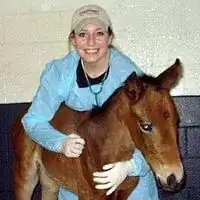 Ryan Corrigan, LVT, VTS-EVNRyan Corrigan is a Licensed Veterinary Technician in California. She received her Bachelor of Science in Veterinary Technology from Purdue University in 2010. She is also a Member of the Academy of Equine Veterinary Nursing Technicians since 2011.
Ryan Corrigan, LVT, VTS-EVNRyan Corrigan is a Licensed Veterinary Technician in California. She received her Bachelor of Science in Veterinary Technology from Purdue University in 2010. She is also a Member of the Academy of Equine Veterinary Nursing Technicians since 2011.
Licensed Veterinary Technician It is best to allow your horse to get accustomed to its new surroundings. However, this does not mean you can’t ride. This may mean walking your horse on a lead around the barn or property. You can also do this from the saddle at a walk - the point isn’t to try to train or “work” your horse, but just to bond with your new horse.
It is best to allow your horse to get accustomed to its new surroundings. However, this does not mean you can’t ride. This may mean walking your horse on a lead around the barn or property. You can also do this from the saddle at a walk - the point isn’t to try to train or “work” your horse, but just to bond with your new horse. -
QuestionWhat if I am getting a horse and I don't have any tack? What do I do then?
 Ryan Corrigan, LVT, VTS-EVNRyan Corrigan is a Licensed Veterinary Technician in California. She received her Bachelor of Science in Veterinary Technology from Purdue University in 2010. She is also a Member of the Academy of Equine Veterinary Nursing Technicians since 2011.
Ryan Corrigan, LVT, VTS-EVNRyan Corrigan is a Licensed Veterinary Technician in California. She received her Bachelor of Science in Veterinary Technology from Purdue University in 2010. She is also a Member of the Academy of Equine Veterinary Nursing Technicians since 2011.
Licensed Veterinary Technician You can look on Craigslist or other resale sites for people selling used tack for cheap. Another option is to wait until online retailers have their summer or holiday sales for deep discounts on tack and supplies.
You can look on Craigslist or other resale sites for people selling used tack for cheap. Another option is to wait until online retailers have their summer or holiday sales for deep discounts on tack and supplies.
Warnings
- Do not let a horse dealer talk you into buying an unsuitable horse. If you hear the dealer say something like "Well, when he's working, you can't even notice the crooked foot," walk away. Beware of excuses being made by the dealer. Always keep your eyes open and take notes to check with others or your vet.⧼thumbs_response⧽
- Make sure you know the difference between a gelding and a stallion. Some people will get rid of an unwanted stallion by trying to convince a less-experienced horse person that it is a castrated male.⧼thumbs_response⧽
References
- ↑ http://www.thehorse.com/articles/29502/how-much-does-a-horse-cost
- ↑ http://www.unwantedhorsecoalition.org/wp-content/uploads/2017/05/UHC03-Alternatives.pdf
- ↑ http://esc.rutgers.edu/fact_sheet/tips-on-buying-your-first-horse/
- ↑ https://stablemanagement.com/articles/land-needed-horse-25313
- ↑ http://esc.rutgers.edu/fact_sheet/tips-on-buying-your-first-horse/
- ↑ http://www.horseandhound.co.uk/features/hhs-ultimate-guide-to-buying-a-horse-314473
- ↑ http://www.horseandhound.co.uk/horse-care/buying-selling-advice/hhs-guide-to-buying-a-horse-choosing-which-horses-to-view-314507
- ↑ http://www.horseandhound.co.uk/features/hhs-ultimate-guide-to-buying-a-horse-314473
- ↑ http://www.horseandhound.co.uk/horse-care/buying-selling-advice/hhs-guide-to-buying-a-horse-choosing-which-horses-to-view-314507
- ↑ http://esc.rutgers.edu/fact_sheet/tips-on-buying-your-first-horse/
- ↑ http://esc.rutgers.edu/fact_sheet/tips-on-buying-your-first-horse/
- ↑ http://esc.rutgers.edu/fact_sheet/tips-on-buying-your-first-horse/
- ↑ http://www.horseandhound.co.uk/horse-care/buying-selling-advice/hhs-guide-to-buying-a-horse-final-questions-and-payment-314519
- ↑ http://esc.rutgers.edu/fact_sheet/tips-on-buying-your-first-horse/
- ↑ http://www.horseandhound.co.uk/horse-care/buying-selling-advice/hhs-guide-to-buying-a-horse-final-questions-and-payment-314519
- ↑ http://www.americanminiaturehorse.com/pets.htm
About This Article
To buy a horse, try searching for horse ads online, in magazines, or at a local tack shop or vet clinic. You can also reach out to horse dealers, who buy and sell horses for a living. Or, if you'd prefer a young horse or a horse with good breeding, you can find a reputable breeder to purchase a horse from. Whichever route you take, make sure you visit the horse in person a few times so you know for sure that it's the right horse for you. For more tips from our Veterinary co-author, like how to decide if you should buy a horse, read on!
